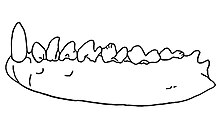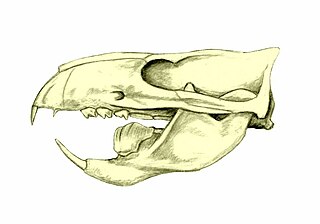
Ptilodus is a genus of mammals from the extinct order of Multituberculata, and lived during the Paleocene in North America.
Neoplagiaulax is a mammal genus from the Paleocene of Europe and North America. In the case of the latter continent, there may possibly be some slightly earlier, Upper Cretaceous material too. It existed in the age immediately following the extinction of the last dinosaurs. This animal was a member of the extinct order Multituberculata, lying within the suborder Cimolodonta and family Neoplagiaulacidae.
Baiotomeus is a genus of mammals from the extinct order of Multituberculata. It is known from the Paleocene of North America.
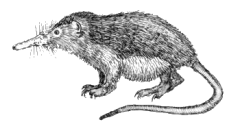
Venomous mammals are animals of the class Mammalia that produce venom, which they use to kill or disable prey, to defend themselves from predators or conspecifics or in agonistic encounters. Venomous mammals are now rare. Mammalian venoms form a heterogeneous group with different compositions and modes of action, from three orders of mammals, Eulipotyphla, Monotremata, and Chiroptera. It has been proposed that some members of a fourth order, Primates, are venomous. To explain the rarity of venom delivery in Mammalia, Mark Dufton of the University of Strathclyde has suggested that modern mammalian predators do not need venom because they are able to kill quickly with their teeth or claws, whereas venom, no matter how sophisticated, requires time to disable prey.
Viverravidae is an extinct family within the clade Carnivoramorpha. They are related to carnivorans, and lived from the early Palaeocene to the Eocene.
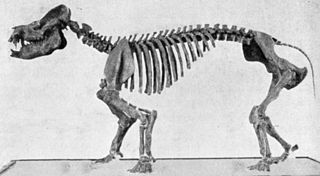
Coryphodon is an extinct genus of mammal.

Oxyaena is an extinct genus of oxyaenid mammal from early Eocene of Europe, Asia and North America. The species were superficially cat or wolverine-like, with a flexible body 1 metre (3.3 ft) long, and short limbs. Some species like Oxyaena forcipata were bigger with a body mass estimated to be 20 kg.

Barylambda is an extinct genus of pantodont mammal from the middle to late Paleocene, well known from several finds in the Wasatchian DeBeque Formation of Colorado and the Clarkforkian Wasatch Formation to Tiffanian Fort Union Formation in Wyoming. Three species of Barylambda are currently recognized. The creature likely lived a life similar to that of a modern tapir, browsing on foliage and soft vegetation. Barylambda seems to have been quite successful for an early pantodont, though eventually it seems to have been replaced in its ecosystem by other pantodonts, such as Coryphodon.

Euchambersia is a genus of therocephalian therapsid that lived during the Late Permian, approximately 255 million years ago, in what is now South Africa. The genus contains a single species, Euchambersia mirabilis, named by paleontologist Robert Broom in 1931 from a skull missing the lower jaws; a second skull, belonging to an immature individual, was later described. It is a member of the family Akidnognathidae, which historically has also been referred by as the synonymous Euchambersiidae.

Sinonyx is a genus of extinct, superficially wolf-like mesonychid mammals from the late Paleocene of China. It is within the family Mesonychidae, and cladistic analysis of a skull of Sinonyxjiashanensis identifies its closest relative as Ankalagon. S.jiashanensis was discovered in Anhui province, China, in the Tuijinshan formation.
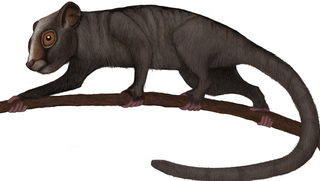
Carpolestes is a genus of extinct primate-like mammals from the late Paleocene of North America. It first existed around 58 million years ago. The three species of Carpolestes appear to form a lineage, with the earliest occurring species, C. dubius, ancestral to the type species, C. nigridens, which, in turn, was ancestral to the most recently occurring species, C. simpsoni.
Didymictis is an extinct genus of carnivorous mammals known from the late Paleocene and early Eocene of North America. This genus in the family Viverravidae contains five species.

Tillodontia is an extinct suborder of eutherian mammals known from the Early Paleocene to Late Eocene of China, the Late Paleocene to Middle Eocene of North America where they display their maximum species diversity, the Middle Eocene of Pakistan, and the Early Eocene of Europe. Leaving no descendants, they are most closely related to the pantodonts, another extinct group. The tillodonts were medium- to large-sized animals that probably feed on roots and tubers in temperate to subtropical habitats.
The Tiffanian North American Stage on the geologic timescale is the North American faunal stage according to the North American Land Mammal Ages chronology (NALMA), typically set from 60,200,000 to 56,800,000 years BP lasting 3.4 million years .

Phenacodontidae is an extinct family of large herbivorous mammals traditionally placed in the “wastebasket taxon” Condylarthra, which may instead represent early-stage perissodactyls. They lived between the Paleocene and Eocene epochs and their fossil remains have been found in North America and Europe, and it is closely related to the horse.
Acidomomys is a plesiadapiform mammal, meaning that is it a precursor to the primates or very closely related to them. It belongs to the family Paromomyidae.
Wyonycteris is a genus of small mammals that existed in the late Paleocene and early Eocene epochs. The type species is Wyonycteris chalix, which lived in Wyoming during the Clarkforkian North American Land Mammal Age of the Paleocene and was originally proposed to be an early form of insectivorous bat. Later re-examination of the material has put this alliance in doubt, and the genus has instead been proposed as belonging to the subfamily Placentidentinae, within the family Nyctitheriidae. Similar fossil material of the same time period found in Europe was later discovered and described as new species, Wyonycteris richardi.
Chiromyoides is a small plesiadapid primatomorph that is known for its unusually robust upper and lower incisors, deep dentary, and comparatively small cheek teeth. Species of Chiromyoides are known from the middle Tiffanian through late Clarkforkian North American Land Mammal Ages (NALMA) of western North America, and from late Paleocene deposits in the Paris Basin, France.

Peradectes is an extinct genus of small metatherian mammals known from the Cretaceous and Paleocene of North and South America through the Eocene of North America and parts of Europe. The first discovered fossil, P. elegans, was one of 15 Peradectes specimens described in 1921 from the Mason pocket fossil beds in Colorado.
Azygonyx was a small tillodont mammal, likely the size of a cat to raccoon, that lived in North America during the Paleocene and Eocene in the early part of the Cenozoic Era. The only fossils that have been recovered are from the Willwood and Fort Union Formations in the Bighorn Basin of Wyoming, United States, and date to the Clarkforkian to Wasatchian, about 56 to 50 million years ago. Fifty-six collections that have been recovered thus far include the remains of Azygonyx. Azygonyx survived the Paleocene Eocene Thermal Maximum along with other mammals like Phenacodus and Ectocion, both of which were ground-dwelling mammals. Azygonyx probably was a generalist terrestrial mammal that may have roamed around the ground, but was also capable of climbing trees.
